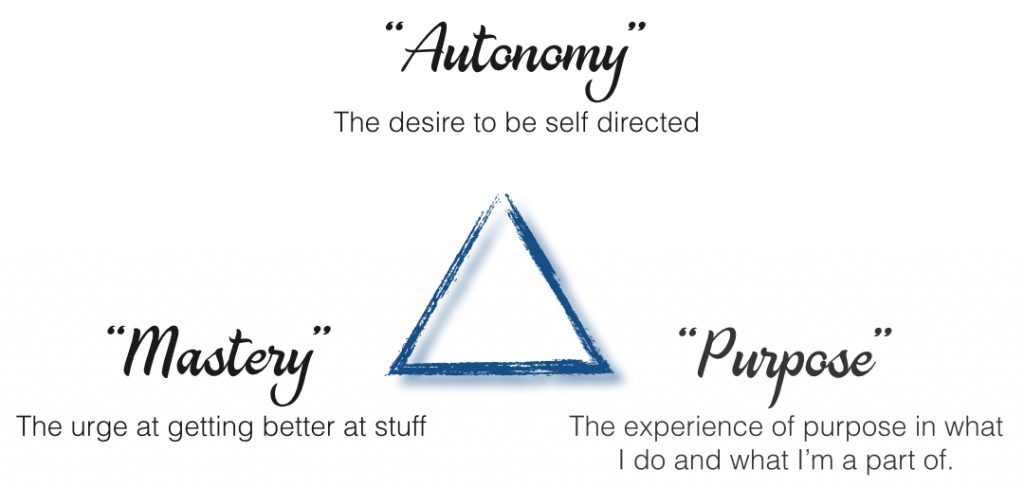Recently, I led a manager seminar on “leading from behind, ” or how to motivate, provide constructive criticism, set up frameworks, and align expectations without having a mandate to lead anyone. Sure, that sounds a bit weird, but that’s another story.
In that context, I showed Daniel Pink’s TEDtalk about what, according to him, are the factors behind motivation. It’s an oldie by now (2009), but the idea he presents about what motivates fascinates me to this day.
Especially the three elements:

An image and a language
The three elements provide an image, and for me, also a language, that is about a lot more than just motivation. It is also about balance in life. I will make the claim that if you are aware of your preferred balance between the three elements of motivation, you have a “thermometer” that can tell you when things are going well and not so well. By having this perspective, or this language, your opportunities for actions and doing something about it, whether this is maintaining a good balance or fixing an imbalance, are augmented.
The world changes all the time, and there is no doubt that the more satisfied you are with your life, the more you are able to handle the ever-changing world. Handle. Because it is not about being strong and standing firm as a cliff but rather about having a suitable balance. And for this balance, there are no set guidelines (unfortunately or luckily, depending on how one looks at it).
Three landmarks towards balance
With the three concepts as landmarks, it is possible to become aware of a suitable balance, and thereby to be able to be flexible and handle what happens at work and in life in general in the best possible way. It also opens a possibility for describing and understanding what happens when you are in balance. This can hopefully make you even better at taking care of yourself. In other words, it opens up more possibilities for action when you want to maintain something good and when you want to change something less good.
So how can it be used?
Firstly, it’s important to find out what your best state is. What would it look like if all three parts were perfectly attuned in relation to one another?
Your best balanced “I”?
What does your best “I” look like? When everything makes sense, when you have control over things (or perhaps precisely no control), and when you are the best at what you do and what you are a part of. It can be moments of different durations, weeks, days, hours, or even minutes, where you experience that autonomy, mastery and purpose are balanced according to one another.
Here is an invitation: Take some time to yourself, find a nice place to sit, and contemplate the following:
Autonomy
What does it look like when you have an ideal amount of autonomy? When do you have sufficient influence on your work and your life?
What do you do in these moments? What do other people notice about you in these moments?
Mastery
What are you already especially good at? Where do you experience yourself as an expert? What are you getting better at right now, towards becoming one of the best, both professionally and privately?
Purpose
Where do you most clearly see purpose in what you do and what you are a part of? Purpose for yourself, and just as much for others who are involved, from bosses to colleagues to your family and friends.
If you can create an image of what your life looks like when these three conditions are met, you have come a long way!
Nothing is constant
There are good days and not-so-good days. This means that the perfect balance is, of course, not constant. There are events during a week that provide for a not-so-good day, and that just need to be over and done, period. I am not asking you to enter the world championships of navel-gazing.
I do, however, experience that sometimes diagnoses are put on too quickly when something doesn’t go according to plan. The reasoning can be that there are too many tasks at the moment, or sick children, which gives rise to worrying and too little sleep, or notifications of upcoming cuts in staff or changes in structure, which create insecurity surrounding tasks and job situations.
This also means that sometimes, not enough time is taken to examine what is actually different when there is an imbalance.
2nd invitation: I would like to invite you to perform a little experiment.
Take the temperature on your balance
If we assume that the three factors apply:
- To have influence and, to a reasonable degree, control one’s job and life.
- To experience oneself as an expert or on the way to becoming better at something.
- That what is done (out of responsibility and desire) is meaningful to oneself and others.
Can we try to get a present overview and a balance status?
For this, you need a worksheet that you can download here:
You can also trace it onto a blank sheet of paper.
On the sheet are three scales from 1 to 10 with the following headlines:
- Autonomy
- Mastery
- Purpose
Think about what these elements look like in reality for you (you already did this earlier in the article), and note down what “10” represents for you, for example:
Autonomy
“10” is for example that:
- I can plan my own tasks as I wish to
- I can plan the number of out-of-town meetings I have with clients.
- (what else?)
Mastery
“10” is for example that:
- Through several meetings, I get better at facilitating and leading towards consensus.
- I experience estimating almost perfectly by eye when I place the machine.
- (what else?)
Purpose
“10” is for example that:
- I can see that my notes from meetings are used at other meetings.
- I hear that customers like how I have planned the process for accepting their complaints.
- (what else?)
Where are you right now?
Remember that the world is ever-changing, so this is only a snapshot. Mark each scale where you estimate that you are right now.
And here comes the interesting part. Ask yourself the following question, where you are satisfied:
What are you doing which puts you where it is satisfying?
No, “Well, that’s just random,” “I’m lucky these days,” or “My boss is in a good mood.” No, what is to your credit that has caused you to be right here and not lower on the scale?
Try to ignore any imperatives, be humble, and give yourself a pat on the back. How have you been capable of bringing yourself to this position?
Mark again
When you look at the scales, the markings you have made, and what has brought you there, where would it be okay to be on the scale if not 10? Mark the scales again, where you would be okay with being. Think about:
What would be different if you were there? Who would do what, and more importantly, what would you do there that you don’t do right now?
If your mark is in the same spot as where you are right now, which means you’re okay with being where you are, then put a ring around your marking and think about:
What tells you that you can remain at this point on the scale and won’t slide down further and away from your okay? What are you doing to help yourself remain at this point on the scale?
Of course, there are days where it is lower, and I apologise for returning to this repeatedly: As with all systems and, in this case, scales, these are snapshots, which, at their best, can give you an overview and thereby increase your opportunities for action.
Take a time-out
Treat yourself, take a time-out, and check your balance. Do you have sufficient control? Are you as skilled as you would like to be, or are you on your way there? Is what you do meaningful for you and those around you?
Or take a time-out when there is something you are unsatisfied with and you can’t put your finger on it.
No matter what, this exercise will dramatically increase the chances of you becoming more wise about yourself and what your options are and aren’t.
Photo by Tom van Hoogstraten on Unsplash






